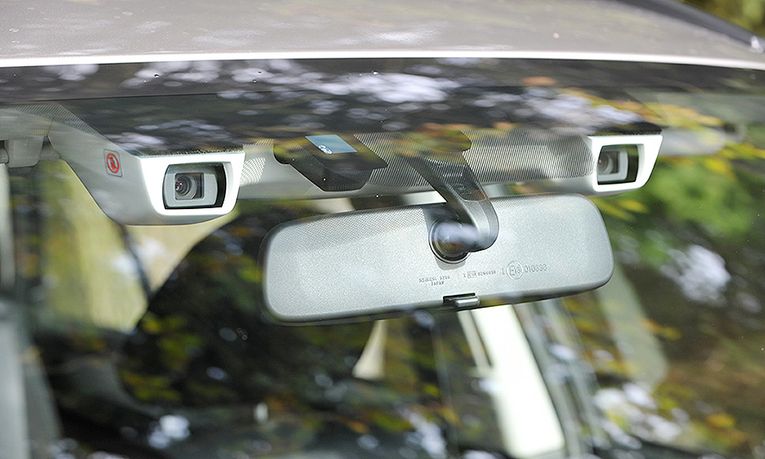| Subaru sharpens EyeSight capabilities in Japan |

Subaru Corp. has partnered with Silicon Valley tech company Xilinx on an enhanced EyeSight safety system with new features that will first launch in the Japanese market.
EyeSight, a stereo vision-based advanced driver-assistance and safety system, will be powered by Xilinx’s UltraScale multiprocessor system-on-chip. This provides the power to process the stereo images into 3D “point clouds” with “ultra-low latency and functional safety,” said Willard Tu, Xilinx’s senior director of automotive.
“That’s really needed so that the EyeSight system can accurately understand and react to dynamic driving situations,” he said.
Other Xilinx customers include established companies such as Daimler, Continental, Magna and Veoneer, but also startups such as Pony.ai.
Subaru’s EyeSight system has two outward-facing interior cameras placed toward the top of the windshield, above the rearview mirror, that scan the road ahead for objects, including vehicles and pedestrians.
Subaru introduced EyeSight in the U.S. in 2012. Currently, EyeSight in the U.S. includes adaptive cruise control, pre-collision braking, pre-collision throttle management, lane-departure and sway warning, lane-departure prevention and lead-vehicle start alert, which tells the driver that the vehicle stopped ahead has resumed moving.
The stereo camera is the core technology of EyeSight, said Eiji Shibata, general manager of automated driving and advanced safety at Subaru. Shibata, speaking through a translator, noted that the automaker has been improving the system’s object and situation recognition for the front and side views.
With the latest version of EyeSight, Subaru has improved the stereo camera, Shibata said.
“This is where the Xilinx feature comes in,” he said. “That allowed to us roughly double the field of view.”
— Jack Walsworth
What you need to know
Cameras a big hit with consumers Drivers appreciate an extra set of eyes on the road. When it comes to tech features, vehicle owners are most enamored with cameras, according to the J.D. Power 2020 U.S. Tech Experience Index. Luxury owners rate camera features highest in five of the six satisfaction attributes measured in the study, which tracks how effective automakers are in bringing advanced technologies to market in ways that consumers find intuitive and not overbearing. Gesture controls were the lowest-rated technology “by far,” the report says.
Lyft to suspend Calif. ride services at midnight Lyft Inc. said Thursday it will suspend its ride-hailing services in California at midnight as a court order takes effect forcing the company to treat its drivers as employees, rather than independent contractors. “This is not something we wanted to do, as we know millions of Californians depend on Lyft for daily, essential trips,” the company said in a blog post. Meantime, Uber Technologies Inc. has said it’s considering licensing its brand to independently operated franchises. The move would create distance between the ride-hailing company and its drivers and would serve as an alternative to classifying them as employees, Bloomberg reports.
GM bets on EVs, new tech to reverse China slide General Motors is overhauling its Chinese lineup with a greater emphasis on electric vehicles and smart-driving technology to stem a slide in sales after more than two decades of growth in a country that contributes nearly a fifth of its profit. More than 40 percent of its new vehicles launching in the country over the next five years are set to be electrified, the U.S. carmaker said on Wednesday.
Roundup
Navya self-driving paratransit shuttle pilot is being deployed to help older people in the Motor City.
Suburban Detroit EV startup Bollinger Motors is doubling its staff and has opened a new headquarters and engineering center.
Another EV startup, Canoo Holdings Ltd., will go public later this year after joining forces with a special-purpose acquisition company.
Toyota Motor Corp. will offer its cars in India on leases or shorter-term subscriptions.
Short-haul autonomous trucking company Gatik focuses its automated driving systems on the “middle mile.”
Chinese electric vehicle maker Nio and Contemporary Amperex Technology Co. will allow customers to lease batteries separately from vehicles, reducing upfront purchase costs.
Uber said it would continue operating its revenue-generating food-delivery business, Uber Eats, even if its ride-hailing business is forced to shut in California.
Western Europe’s electrified-vehicle sales pulled ahead of China’s last month, Bloomberg reports.
Brain food
Getting people to accept self-driving vehicles starts with showing how the technology can make their lives safer, easier and better, writes Greg Brannon, director, automotive engineering, for AAA.
Last mile
“Semiautonomous” deserves more respect, says Kiwibot co-founder Felipe Chavez, whose company launched 25 delivery robots in San Jose, Calif., last month.